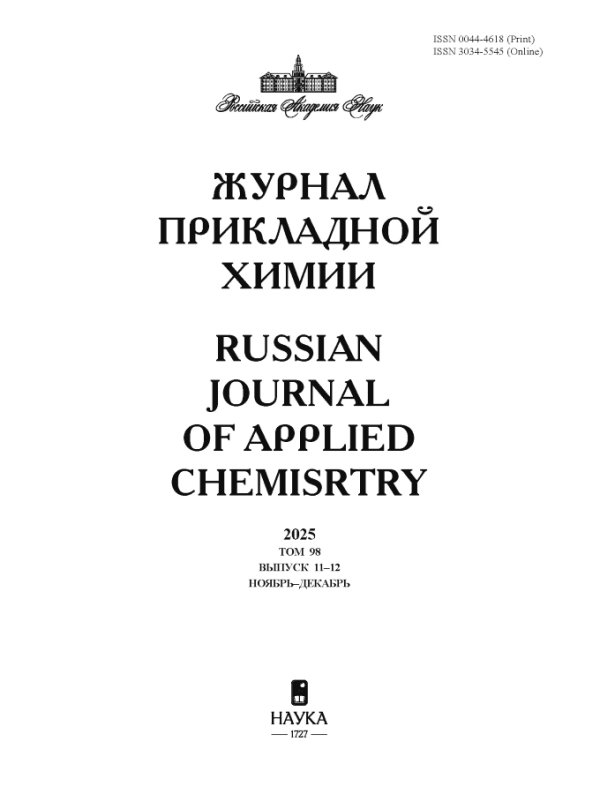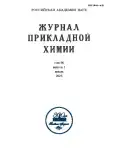Preparation, Structure, and Properties of Chitosan Microtubes
- Authors: Shipovskaya A.B.1, Gegel' N.O.1, Babicheva T.S.1, Golyadkina A.A.1
-
Affiliations:
- Chernyshevsky Saratov State University, 410012, Saratov, Russia
- Issue: Vol 96, No 1 (2023)
- Pages: 69-83
- Section: Articles
- URL: https://journals.rcsi.science/0044-4618/article/view/141702
- DOI: https://doi.org/10.31857/S0044461823010097
- EDN: https://elibrary.ru/HUYTKR
- ID: 141702
Cite item
Full Text
Abstract
Procedures were developed for forming hollow cylindrical structures with the wall thickness in the micrometer range (microtubes) from chitosan solutions in citric, lactic, and glycolic acids. The procedures are based on the phase-transfer neutralization induced by the transport of ions (hereinafter, ion-induced reaction), occurring at the liquid–liquid or solid–liquid interface, namely, on the polymer-analogous conversion of the salt form of the polymer to the base form in a NaOH or triethanolamine medium or formation of a water-insoluble polyelectrolyte complex with sodium dodecylbenzenesulfonate. Comparative analysis of the dependences of the morphological, structural, elastoplastic, physicomechanical, and biological properties of the structures on the reaction conditions and kind of the organic acid and neutralizing agent was made. The microtubes prepared from a chitosan solution in glycolic acid by ion-induced neutralization at the solid–liquid interface in a NaOH or triethanolamine medium exhibit the optimum levels of strength and elasticity, comparable with those of a fragment of human carotid artery and xenopericardial patch. The hemo- and biocompatibility and controlled biodegradation of these materials make them promising as analogs of biodegradable blood vessel implants.
About the authors
A. B. Shipovskaya
Chernyshevsky Saratov State University, 410012, Saratov, Russia
Email: acjournal.nauka.nw@yandex.ru
N. O. Gegel'
Chernyshevsky Saratov State University, 410012, Saratov, Russia
Email: acjournal.nauka.nw@yandex.ru
T. S. Babicheva
Chernyshevsky Saratov State University, 410012, Saratov, Russia
Email: acjournal.nauka.nw@yandex.ru
A. A. Golyadkina
Chernyshevsky Saratov State University, 410012, Saratov, Russia
Author for correspondence.
Email: acjournal.nauka.nw@yandex.ru
References
- Wang J., Zhuang S. Chitosan-based materials: Preparation, modification and application //j. Clean. Prod. 2022. V. 355. ID 31825. https://doi.org/10.1016/j.jclepro.2022.131825
- Rinaudo M. Chitin and chitosan: Properties and applications // Progress Polym. Sci. 2006. V. 31. N 7. P. 603-632. https://dx.doi.org/10.1016/j. progpolymsci.2006.06.001
- Мударисова Р. Х., Кулиш Е. И., Зинатуллин P. M., Таминдарова Н. Э., Колесов С. В., Хунафин С. Н., Монаков Ю. Б. Пленки комплексов на основе хитозана с контролируемым высвобождением левомицетина // ЖПХ. 2006. Т. 79. № 10. С. 1737-1739. EDN: HVKFJH
- Li X., Tang J., Bao L., Chen L., Hong F. F. Performance improvements of the BNC tubes from unique double-silicone-tube bioreactors by introducing chitosan and heparin for application as small-diameter artificial blood vessels // Carbohydr. Polym. 2017. V. 178. P. 394-405. https://doi.org/10.1016/j.carbpol.2017.08.120
- Yin K., Divakar P., Wegst U. G. K. Freeze-casting porous chitosan ureteral stents for improved drainage // Acta Biomater. 2019. V. 84. P. 231-241. https://doi.org/10.1016/j.actbio.2018.11.005
- Al Rez M. F., BinObaid A., Alghosen A., Mirza E., Alam J., Hashem M., Alsalman H., Almalak H. M., Mahmood A., Moussa I., Al-Jassir F. F. Tubular poly(ε-caprolactone)/chitosan nanofibrous scaffold prepared by electrospinning for vascular tissue engineering applications //j. Biomater. Tissue Eng. 2017. V. 7. P. 427-436. https://doi.org/10.1166/jbt.2017.1593
- Попрядухин П. В., Юкина Г. Ю., Суслов Д. Н., Добровольская И. П., Иванькова Е. Н., Юдин В. Е. Биорезорбция пористых 3D-материалов на основе хитозана // Цитология. 2016. Т. 58. № 10. P. 771- 777. EDN: XWRWWD
- Badhe R. V., Bijukumar D., Chejara D. R., Mabrouk M., Choonara Y. E., Kumar P., du Toit L. C., Kondiah P. P. D., Pillay V. A composite chitosan-gelatin bi-layered, biomimetic macroporous scaffold for blood vessel tissue engineering // Carbohydr. Polym. 2017. V. 157. P. 1215-1225. https://doi.org/10.1016/j.carbpol.2016.09.095
- Zhao X., Liu S., Han Y., Wang Y., Lin Q. Preparation of 5-fluorouracil loaded chitosan microtube via in situ precipitation for glaucoma drainage device application: in vitro and in vivo investigation //j. Biomater. Sci. Polym. Ed. 2021. V. 32. N 14. P. 1849-1864. https://doi.org/10.1080/09205063.2021.1946460
- Macêdo M. D. M., de Lucena B. M., de Cerqueira G. R. C., de Sousa W. J. B., Pedrosa T. C., Barbosa R. C., de Azevedo A. C. S., de Souza M. F., de Oliveira D. K. M., Fook M. V. L. Tubular chitosan device for use as prosthesis coating in vascular surgery // Res. Soc. Develop. [S. l.]. 2021. V. 10. N 4. P. e25610414031. https://doi.org/10.33448/rsd-v10i4.14031
- Neufurth M., Wang X., Tolba E., Dorweiler B., Schröder H. C., Link T., Diehl-Seifert B., Muller W. E. G. Modular small diameter vascular grafts with bioactive functionalities // PLoS ONE. 2015. V. 10. N 7. P. e0133632. https://doi.org/10.1371/journal.pone.0133632
- Beda A., Yamada H., Egunov A., Ghimbeu C. M., Malval J. P., Saito Y., Luchnikov V. Carbon microtubes derived from self-rolled chitosan acetate films and graphitized by joule heating //j. Mater. Sci. 2019. V. 54. N 16. P. 11345-11356. https://doi.org/10.1007/s10853-019-03675-6
- Lugovitskaya T. N., Shipovskaya A. B., Shmakov S. L., Shipenok X. M. Formation, structure, properties of chitosan aspartate and metastable state of its solutions for obtaining nanoparticles // Carbohydr. Polym. 2022. V. 277. ID 118773. https://doi.org/10.1016/j.carbpol.2021.118773
- Шиповская А. Б., Малинкина О. Н., Гегель Н. О., Зудина И. В., Луговицкая Т. Н. Структура и свойства солевых комплексов хитозана с диастереомерами аскорбиновой кислоты // Изв. АН. Сер. хим. 2021. № 9. С. 1765-1774. EDN: TVLXSM
- Babicheva T. S., Konduktorova A. A., Shmakov S. L., Shipovskaya A. B. Formation of Liesegang structures under the сonditions of the spatiotemporal reaction of polymer-analogous transformation (salt→base) of chitosan //j. Phys. Chem. B. 2020. V. 124. N 41. P. 9255-9266. https://doi.org/10.1021/acs.jpcb.0c07173
- Qiao C., Ma X., Wang X., Liu L. Structure and properties of chitosan films: Effect of the type of solvent acid // LWT. 2021. V. 135. ID 109984. https://doi.org/10.1016/j.lwt.2020.109984
- Melro E., Antunes F. E., da Silva G. J., Cruz I., Ramos P. E., Carvalho F., Alves L. Chitosan films in food applications. Tuning film properties by changing acidic dissolution conditions // Polymers. 2021. V. 13. N 1. ID 1. https://doi.org/10.3390/polym13010001
- Nie J., Lu W., Ma J., Yang L., Wang Z., Qin A., Hu Q. Orientation in multi-layer chitosan hydrogel: Morphology, mechanism and design principle // Sci. Reports. 2015. V. 5. N 1. P. 1-7. https://doi.org/10.1038/srep07635
- Li B., Gao Y., Feng Y., Ma B., Zhu R., Zhou Y. Formation of concentric multilayers in a chitosan hydrogel inspired by Liesegang ring phenomena //j. Biomater. Sci. Polym. Ed. 2011. V. 22. N 17. P. 2295- 2304. https://doi.org/10.1163/092050610X538425
- Babak V. G., Merkovich E. A., Galbraikh L. S., Shtykova E. V., Rinaudo M. Kinetics of diffusionally induced gelation and ordered nanostructure formation in surfactant-polyelectrolyte complexes formed at water/water emulsion type interfaces // Mendeleev Commun. 2000. V. 10. N 3. P. 94-95. https://doi.org/10.1070/MC2000v010n03ABEH001227
- Базунова М. В., Мустакимов Р. А., Бакирова Э. Р. О формировании устойчивых полиэлектролитных комплексов на основе N-сукцинила хитозана и поли-N,N-диаллил-N,N-диметиламмоний хлорида // ЖПХ. 2022. Т. 95. № 1. С. 42-48. https://doi.org/10.1134/S1070427222010062
- Gegel N. O., Shipovskaya A. B., Vdovykh L. S., Babicheva T. S. Preparation and properties of 3D chitosan microtubes //j. Soft Matter. 2014. V. 2014. ID 863096. http://dx.doi.org/10.1155/2014/863096
- Голядкина А. А, Иванов Д. В., Кириллова И. В., Коссович Е. Л., Павлова О. Е., Полиенко А. В., Сафонов Р. А. Биомеханика сонной артерии. Саратов: Саратовский источник, 2015. С. 70. EDN: VIKEJR
- Агеев Е. П., Вихорева Г. А., Зоткин М. А., Матушкина Н. Н., Герасимов В. И., Зезин С. Б., Оболонкова Е. С. Структура и транспортные свойства хитозановых пленок, модифицированных термообработкой // Высокомолекуляр. соединения. 2004. Т. 46А. № 12. С. 2035-2041. EDN: NEMWOV
- Shipovskaya A. B., Shmakov S. L., Gegel N. O. Optical activity anisotropy of chitosan-based films // Carbohydr. Polym. 2019. V. 206. Р. 476-486. https://doi.org/10.1016/j.carbpol.2018.11.026
- Жанкалова З. М. Показатели перекисного окисления липидов у больных с алкогольной болезнью печени // Медицина и экология. 2008. Т. 48. № 3. P. 31-33. https://qmu.edu.kz/media/qmudoc/Journal3-08.pdf
- Zhang L., Dou S., Li Y., Yuan Y., Ji Y., Wang Y., Yang Y. Degradation and compatibility behaviors of poly (glycolic acid) grafted chitosan // Mater. Sci. Eng. Part C. 2013. V. 33. N 5. P. 2626-2631. https://doi.org/10.1016/j.msec.2013.02.024
- Кулиш Е. И. Чернова В. В., Володина В. П., Колесов С. В. Биодеградация пленочных полимерных покрытий на основе хитозана //Вестн. Башкир. ун-та. 2008. Т. 13. № 1. С. 23-26. EDN: IPVEKV
Supplementary files










